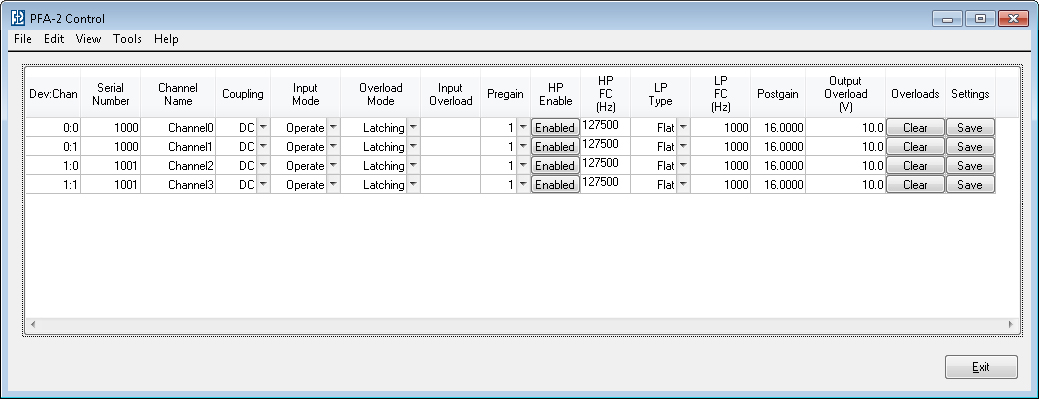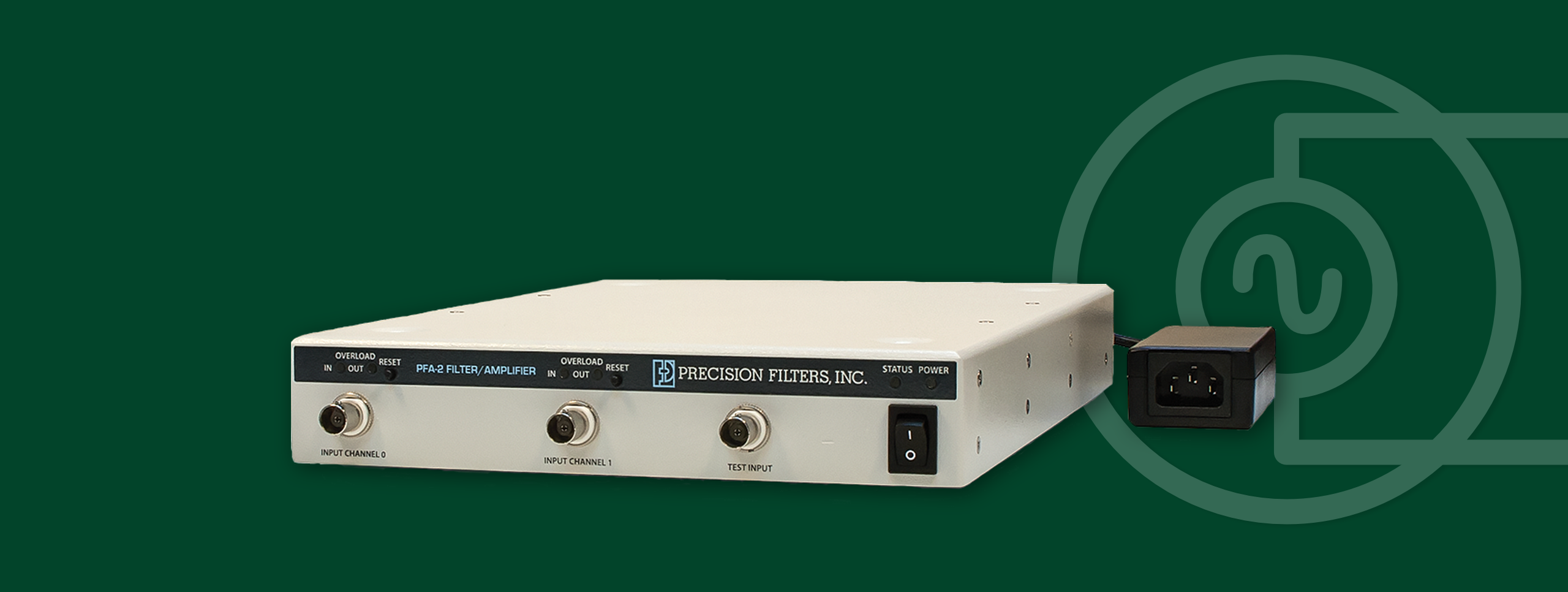PFA-2 Two-Channel Compact Filter/Amplifier
Precision quality and performance in an economical benchtop package
Precision PFA-2 Filter/Amplifier offers 2 channels of high-performance signal conditioning for low-level voltage inputs in an economical benchtop package.
PFA-2 Description
The PFA-2, Precision Filters’ dual-channel filter/amplifier, is compact, rugged, and versatile. Its low-noise, high common-mode rejection balanced differential input with programmable AC/DC input coupling makes the PFA-2 ideal for conditioning static or dynamic signal inputs. Its 6-pole low-pass filters can address applications in the time domain, such as shock measurements, or in the frequency domain, such as spectral analysis or anti-aliasing applications.
Gain is distributed before and after the filter, eliminating out-of-band energy such as transducer resonant peaking, which can clip the amplifier and ruin the data. Front-panel overload detectors warn about pre- and postfilter overload conditions that might otherwise be masked by the filter. The optional 2-pole high-pass filter provides programmable low-frequency roll-off to attenuate sources of low-frequency noise.

PFA-2 Spreadsheet-Style GUI
The PFA-2 is highly programmable via its spreadsheet-style graphical user interface. The GUI controls up to eight PFA-2 units as a single system. Alternatively, you can control the PFA-2 using a high-level command interface via a USB 2.0 connection. Save configurations to the host computer and recall them later. Or save settings to nonvolatile memory for field deployment—no host computer needed.

Precision Dual-Channel Compact Filter/Amplifier System
Innovative Technologies and Features:
Pre-Filter and Post-Filter Gain
The PFA-2 distributes amplifier gain both before and after the filter to provide protection from large out-of-band energy or transients that could cause clipping before the filter, distorting the data... Read More
Flat/Pulse Low-Pass Filter Technology
PFA-2 low-pass filters may operate either in a flat mode, for maximally flat pass-band amplitude response with sharp roll-off, or in a pulse mode, for low phase distortion and optimized transient response. Flat mode provides passband characteristics nearly identical to a Butterworth filter while providing a much sharper roll-off. This mode is a good choice for applications such as spectral analysis. Pulse mode has time-domain response similar to the Bessel filter yet provides superior amplitude response characteristics. Pulse mode is ideal for time-domain applications, including transient (shock) measurements and waveform analysis.
Balanced Differential Input Topology
The PFA-2 Filter/Amplifier input stage is a balanced differential input topology that may be used to receive differential signals from a bridge type transducer or to condition grounded (single-ended) voltage sources without introducing ground loops. The input is versatile in that it has low DC drift for DC measurement applications, low noise for wideband AC measurements and is equipped with programmable AC/DC coupling. AC coupling is useful for eliminating large DC bias on the signal so that more channel gain can be applied in order to emphasize small AC fluctuations in the signal.
PFA-2 Salient Features:
Number of Channels:
- 2 per system
Input Connectors:
- Standard: Coaxial BNC’s at front panel
- Option 1: Twinaxial BNC input ... Read More
Number of Channels:
- 2 per system
Input Connectors:
- Standard: Coaxial BNC’s at front panel
- Option 1: Twinaxial BNC input
Output Connectors:
- Individual isolated BNC’s at rear panel
Inputs:
- Balanced differential input with programmable AC/DC coupling
Outputs:
- DC coupled, single-ended output, short circuit protected
Test Support:
- Amplifier Short: A switch at the amplifier input is utilized to ground the input stage for measurement of noise and DC offset.
- Test Input: Switch disconnects signal from input connector and inject signal on Test Input BNC at the amplifier input.
Input Power:
- 10 to 30 VDC external AC to DC power supply provided with unit
Pre-Filter Gain:
- x1 to x128 in binary steps
Post-Filter Gain:
- x1/16 to x16 with 0.025% minimum resolution
Filters:
- 4-pole low-pass filters with programmable flat/pulse characteristics
- Wideband mode: Filter may be removed from the signal path, resulting in 3-pole Butterworth wideband amplifier frequency response with nominal –3 dB frequency at 500 kHz.
- Optional 2-pole high-pass filter (Option H) for band-pass operation
Control:
- USB remote control with field upgradable firmware
- Spreadsheet-style GUI interface for control of up to 8 PFA-2 units
- Nonvolatile memory saves programmed state for field deployment without an attached control computer
- Input and output overload detection with programmable threshold
Comparison Chart of Precision Filter/Amplifiers Products
For PDF version, click here
| System/Card | PFA-2 Filter/Amplifier System | PF-1U-FA High-Performance Filter/Amplifier System | PF-1U-FA Standard-Performance Filter/Amplifier System | 28608B 8-Channel 200 kHz Filter/Amplifier Module | 28618 8-Channel 200 kHz Filter/Amplifier Module | 28612 2-Channel 3 MHz Filter/Amplifier Module |
| Channels/ Card | 2 per system | 8 (PF-1U-8FA) or 16 (PF-1U-16FA) |
8 (PF-1U-8FA) or 16 (PF-1U-16FA) |
8 per card; up to 128 per 28000 system | 8 per card; up to 128 per 28000 system | 2 per card; up to 32 per 28000 system |
| Inputs | Balanced differential inputs with programmable AC/DC coupling | Balanced differential inputs with programmable AC/DC coupling; Option I: IEPE Current Source | Balanced differential inputs with programmable AC/DC coupling; Option I: IEPE Current Source | Balanced differential inputs with programmable AC/DC coupling | Balanced differential inputs with programmable AC/DC coupling | Programmable single-ended/differential input with programmable AC/DC input coupling (10 Hz or 100 Hz) |
| Filter | 6-pole Flat/Pulse Low-Pass; Option H: 2-pole High-Pass |
4- or 8-pole Flat/Pulse Low-Pass or 8-Pole Band-Pass | 4-Pole Flat/Pulse Low-Pass | 4- or 8-pole Flat/Pulse Low-Pass or 8-Pole Band-Pass | 4-pole Flat/Pulse Low-Pass | 6-pole Flat/Pulse Low-Pass |
| Gain | Pre-filter Gain: ×1 to ×128 in ×2 steps
Post-filter Gain: |
Pre-filter Gain: ×1 to ×512 in ×2 steps
Post-filter Gain: |
Pre-filter Gain: ×1 to ×512 in ×2 steps
Post-filter Gain: |
Pre-filter Gain: ×1 to ×512 in ×2 steps
Post-filter Gain: |
Pre-filter Gain: ×1 to ×64 in ×2 steps
Post-filter Gain: |
x1, x2, x5, x10, x20, x50, x100, x200, x500, x1000 |
| Cutoff Frequencies | 5 Hz to 2.555 kHz in 5 Hz steps
2.75 kHz to |
Flat Mode: 2 Hz to 2.046 kHz in 2 Hz steps; 2.2 kHz to 204.6 kHz in 200 Hz steps; bypass option
Pulse Mode: |
FX02: 300 Hz, 1 kHz, 3 kHz, 10 kHz, 30 kHz | Flat Mode: 2 Hz to 2.046 kHz in 2 Hz steps; 2.2 kHz to 204.6 kHz in 200 Hz steps; bypass option
Pulse Mode: |
FX02: 300 Hz, 1 kHz, 3 kHz, 10 kHz, 30 kHz |
5 kHz to 315 kHz in 5 kHz steps 350 kHz to 3.15 MHz in 50 kHZ steps |
| Outputs | DC-coupled, Single-ended | DC-coupled, Single-ended | DC-coupled, Single-ended | Single-ended with Ground Sense | Single-ended with Ground Sense | Single-ended |

